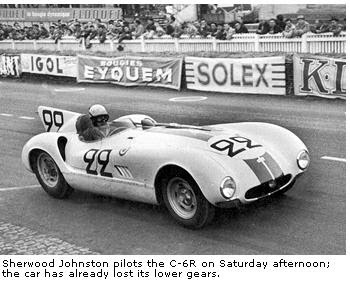Tyre cooling maybe? Or some early form of air-pressure venting for the wheel arch area?
Given the lack of wind tunnels back then I guess it was often a case of suck-it-and-see with any aerodynamic development.
The car looks so much better with the vents blanked off!
Thanks to some help from Cunningham Motorsport Historian Lawrence W. Berman, Paul Kierstein from the photo archive and Sondre Kvipt in Norway I have managed to solicit this response to some of the questions raised here from the C6R's designer Mr. Bud Unger. Quotations are unedited.

"I received your E-mail concerning questions about air vents appearing and disappearing in the rear fenders of the C-6 Cunningham? I could not find the Link. and without a picture of what your friends are questioning, I don’t have a clue as to what they want o know?
All their questions about “holes were cut’ , air ducting, holes appearing an disappearing are all strange terms to me. In fact, the water cooled brake experimenting project was tried on another experimental Ferrari car ,not the C-6. So what your friends are seeing might be an illusion in the picture? No changes in body design of the C-6 after I finished the car and it was entered in the LeMans , France race were made. The changes, to resemble jaguar styling, were made long after I had finished building the C-6,and prior to it being placed in the Museum in Naples, Florida. Allow me to start from the beginning : When I was assigned the project of designing and building The C-6 Cunningham, the air cooled brake project was past tense, but was a factor in my design assignment by Briggs. The engineers wanted maximum air flow to the brakes front and rear! So, the entire shaping of the body styling was a factor. I made the front air intake as large as possible and also extra air intake on both sides beside the main grille air intake . Next, I tapered the side of the body in from the front fenders all the way back to the rear fenders and by large air scoops to get maximum ram air into both rear brakes. This design is very evident and noticeable in all the photos! That is about all that I can help you with at this time."

After seeing the links to this thread Mr Unger continued ...
"I looked at the three links. It looks to me that all three pictures were taken of the C-6
at the same race at Le Mans 24 hour race? For some unknown reason the picture taken at the pit stop does not show the vents in the back fenders?, but the other two clearly do? A mystery? But, the C-6 , in all three links reflects exactly the way that I designed it in every detail!"
The blow up above appears to show the blanking off a little more clearly.
I have passed on our collective thanks to Mr Unger for his response.


























